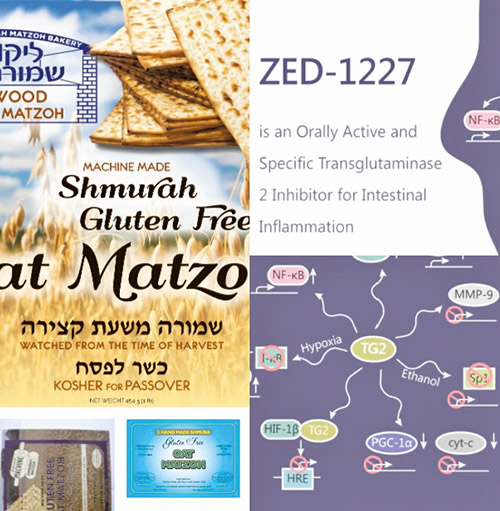
Before we begin, it is important to know that there is a Torah mitzvah to be sensitive to people with celiac disease. Really. People who suffer from this digestive disorder, also known as sprue, have it very hard at pretty much any simcha.
In order for them to eat they need to know what items may have gluten, and, unfortunately, it is generally not at the top of people’s agendas. Caterers and chefs generally only have a general idea of what they put in the foods that are cooked and it is often difficult to ascertain what was put in the foods that were ordered from elsewhere.
It is a Torah mitzvah to put this at the top of one’s agenda. The mitzvah is “v’ahavta l’rayacha kamocha—love your neighbor as yourself.” It can also be a negative mitzvah too: the prohibition of “v’lifnei iver lo sitein michshol—do not put a stumbling block in front of the blind.”
A celiac patient once remarked, “Do you know how people cannot wait to buy pizza or eat chametz after Pesach? That is how I feel all year round.” About 1 in 141 people in the United States have celiac, according to the National Institute of Diabetes and Digestive and Kidney Diseases, but it seems that it is significantly higher, according to schools and caterers.
Another important note. Cakes and desserts over Pesach are often gluten-free. After Pesach, why not offer them to someone with celiac disease? It would be a fantastic method of fulfilling v’ahavta l’rayacha kamocha.
What Is Gluten and What Does It Do?
Gluten is a protein that is found in foods made with wheat, barley, rye and something that was artificially made from female wheat and male rye called “triticate.”
In celiac disease, the body’s immune response to gluten creates poisons or toxins. These poisons destroy the villi in the small intestine, the tiny finger-like protrusions that enable the body to absorb nutrients. This can lead to malnutrition and other very serious health issues including permanent damage to the intestines. The poisons literally eat out the kishkes.
The following foods are what celiacs need to watch out for.
- beer
- bread
- cakes and pies
- candy
- cereals
- cookies
- crackers
- croutons
- gravies
- imitation meat or fish
- oats
- pasta
- processed meats
- salad dressings
- sauces (includes soy sauce)
- basted poultry
- soups
Gluten can also be found in some medicines, many vitamins, and even in lipsticks.
Pesach Halachos
So now, let’s get to the halachos. Pesach is different from challah on Shabbos because on Pesach there is a Torah mitzvah to consume matzah.
Oat matzah consumption for those with celiac disease has become nearly universally accepted. But it is not recommended at all for others. Why is this so? The issue is in the manufacturing process of oat flour. In order to remove the possibility of bitter taste, oats are roasted.
There is a debate between the Ramban and the Rambam as to how to interpret the Talmudic passage as to what is eligible for matzah: It must have the ability to become chametz. The question is what does this mean? Does it refer to the grain in general? Or does it refer to the particular grain that is now being used? Since the oat flour is roasted, it can no longer become chametz!
The Ramban would invalidate it, while the Rambam validates it. The Chayei Adam rules in accordance with the Rambam but the Aruch HaShulchan rules like the Ramban.
So if one is able to eat regular wheat matzah without it causing damage or excessive difficulty, one should do so. If the new Zed1227 medication passes its final phase of clinical trials and is ultimately marketed—then one would be obligated to take it.
If he can eat two kezaysim then he should split it up. He should eat one before his meal with achilas matzah and one for afikoman. He should skip korech.
If even eating one kezayis is difficult, the Tzitz Eliezer (Vol. XIX Siman 22) writes that it depends: If the doctor says that it will cause him or her even slight damage, it is prohibited to eat the matzah. (See also Tzohar Vol. XV, responsum of Rav Chaim zt”l.)
If it will not cause even slight damage, but will cause tolerable stomach ache, cramps or diarrhea, then he or she should force themselves to eat the minimum amounts discussed below.
If two kezaysim of matzah are too much, one should only eat one kezayis (see also Biur Halacha 475 “Kezayis). It is this author’s opinion that one need not even be concerned to fulfill the larger kezayis shiur of half an egg (see MB 486:1), but each individual can speak to their own rav or posek.
If, during the year, the celiac patient will occasionally have gluten, then he or she must have a kezayis on Pesach too. He or she can have oat matzah—even lechatchilah.
Oat Matzah
The vast majority of gedolim hold that oats are, in fact, the shiboles shual discussed in the Mishnah. They include Rav Moshe Feinstein, zt”l, Rav Shlomo Zalman Auerbach, zt”l, Rav Elyashiv, zt”l, and Rav Vosner. This author had also seen other modern evidence that oats were cultivated for animal food in Egypt, and it is mentioned by Galen who lived before the Mishnah was compiled (see Galen, De Alimentis, li. i. cap.12).
There are three types of oat flour now in use. There is roasted oat flour and non-roasted. Matzah made with the non-roasted variety is bitter-tasting, but on the plus side it fits both definitions of what matzah can be made out of. There is also an 80% roasted oat flour that can still become chametz and is not so bad tasting.
If on the other days of Pesach the lack of oat matzah would cause a lack of simchas Yom Tov, many poskim, including Rav Elyashiv, zt”l (see Darchei Horaah Vol. I), allow the use of oat matzah for the rest of Yom Tov too.
If someone wishes to make matzah out of a mixture of raw oats (bitter) and roasted oats (not bitter) he should use a 55% mixture of raw and 45% mixture of roasted oats. Potato flour should never be added.
If one can only eat one kezayis and is making the Seder alone, the one kezayis should be eaten as the afikoman in accordance with the view of the Mishnah Berurah and Magen Avrohom (see MB 482:6).
Of course, as in all areas of Halacha, check with your own rav or posek.
The author can be reached at yairhoffman2@gmail.com.














